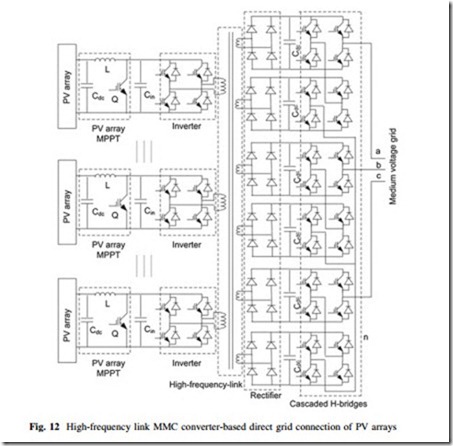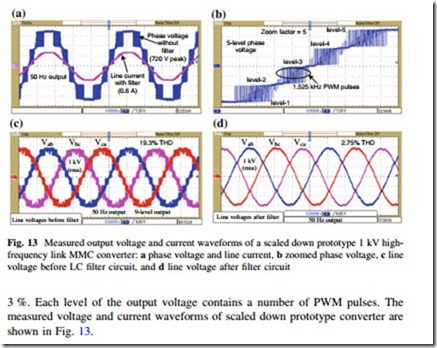High-Frequency Link MMC Converter
The MMC converter requires multiple isolated dc sources that must be balanced, and therefore its application is not straightforward, especially in medium- and large-scale renewable power generation applications. Although it is well reported that the above limitation is not major in solar PV and fuel cell applications, grid connected medium or large-scale generation may suffer from some critical prob- lems. In 2012, by combination of a few quasi-Z source inverters into an MMC converter, a medium voltage PV inverter was proposed [25], where the quasi-Z source inverters generate dc supplies for the floating H-bridge cells of the MMC converter. The proposed converter system does not have electrical isolation between PV array and medium voltage grid. Multiple isolated high-frequency link- based medium voltage PV inverter topology was proposed [26], where the high- frequency link generates dc supplies for the MMC converter. In these proposed systems, the voltage balancing is the challenging issue, since each module is connected to a PV array through separate dc/dc converter. In 2012, a common dc- linkbased PV inverter was proposed [27]. Although this design may reduce the voltage balancing problem in grid side, the generation of common dc-link voltage from different PV arrays makes the converter operation complex and limits the range of operation of the maximum power point tracker (MPPT).
In 2008, a multi-coil modular permanent magnet generator-based medium voltage MMC converter was proposed to eliminate the step-up transformers of wind turbine generators [28]. This multi-winding generator generates multiple dc sup- plies for all the H-bridge cells of the MMC converter, which requires a special winding arrangement (still large weight and volume due to power frequency operation) and complicated control strategies. An improved control strategy was proposed and verified on an almost similar generator converter system [29]. In 2010, another approach to eliminate the step-up transformers of wind turbine generators with medium voltage MMC converter was proposed [30]. A few 6-phase generators are placed in the wind turbine nacelle to generate multiple dc supplies for all the H-bridge inverter cells of the MMC converter. However, these approaches require special modular generators or multiple traditional generators to gen- erate isolated multiple dc supplies for all the H-bridge inverter cells of the MMC converter, and introduce electrical isolation problem between generator and grid.
On the other hand, compared with the conventional transformers operated at the power frequency, the high-frequency transformers have much smaller and lighter magnetic cores and windings, and thus much lower costs, which have already been widely used in the low voltage applications. Operated at 1.2 kHz, the weight and size of a 3 MW transformer can be less than 8 % of an equivalent 50 Hz unit [31]. Therefore, advanced magnetic material-based common high-frequency link may be the natural choice to generate multiple isolated and balanced dc supplies for the MMC converter. To verify the feasibility of the new concept of generation of balanced multiple sources from single source with a high-frequency link, a com- prehensive preliminary analysis was reported in [32]. A high-frequency link MMC medium voltage converter is developed for step-up-transformer-less direct grid integration of renewable sources. Figure 12 shows high-frequency link MMC medium voltage converter for direct grid integration of solar PV arrays.
This converter can also be well applicable in wind turbine generator systems with the replacement of PV array MPPT circuit by a rectifier circuit. The common magnetic-link generates multiple isolated and balanced dc supplies for the modular MMC from a single or multiple renewable sources. The grid electrical isolation and voltage unbalance problems are solved through the common high-frequency link. The high-frequency link MMC medium voltage converter-based grid integration system will have the following advantages: (i) no requirement of special or
multiple generators for wind turbine generator systems, (ii) wide range of MPPT operation for PV systems, (iii) inherent dc-link voltage balance due to common magnetic-link, (iv) direct gird connection without using step-up transformer, (v) overall compact and lightweight system, and (vi) inherently minimizing the grid isolation problem through high-frequency link. To verify the feasibility of the high-frequency link MMC converter, a scaled down 1.73 kVA laboratory proto- type system with 3-phase 5-level MMC converter is developed, which converts 210 V dc (PV array voltage) into 3-phase 1 kV rms 50 Hz ac. Metglas amorphous alloy 2605S3A- and 2605SA1-based 10 kHz magnetic links are developed to generate the isolated and balanced 6 dc supplies for the 3-phase 5-level MMC converter. As measured, before the filter circuit, the 9-level output line voltage waveform contains about 19.3 % THDs and after the filter it is reduced to less than

